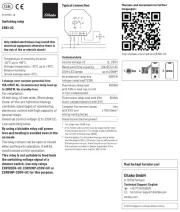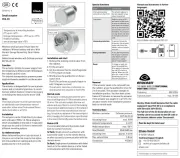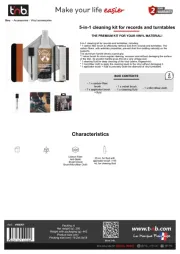Eltako FJ62NP-230V Handleiding
Eltako
Niet gecategoriseerd
FJ62NP-230V
Bekijk gratis de handleiding van Eltako FJ62NP-230V (2 pagina’s), behorend tot de categorie Niet gecategoriseerd. Deze gids werd als nuttig beoordeeld door 22 mensen en kreeg gemiddeld 4.0 sterren uit 11.5 reviews. Heb je een vraag over Eltako FJ62NP-230V of wil je andere gebruikers van dit product iets vragen? Stel een vraag
Pagina 1/2

Wireless shading element and
roller shutter actuator
FJ62NP-230V
GB
Temperature at mounting location:
-20°C up to +50°C.
Storage temperature: -25°C up to +70°C.
Relative humidity:
annual average value <75%.
30 200 535 - 3
Only skilled electricians may install this
electrical equipment otherwise there is
the risk of re or electric shock!
Wireless shading element and roller shutter
actuator 1+1 NO contact, 4 A/250 V AC, not
potential free, for a shading element motor
230 V AC. Standby loss only 0.6 watt.
For installation. 49x51 mm, 20 mm deep.
The terminals are plug-in terminals for
conductor cross-sections of 0.2 mm2 to
2.5 mm2.
The convenient wireless technology permits
the teach-in of up to 32 wireless universal
pushbuttons, wireless direction pushbuttons
and wireless central control pushbuttons.
Zero passage switching.
Bidirectional wireless switchable.
Supply voltage, switching voltage and
control voltage local 230 V.
If supply voltage fails, the device is
switched off in de ned mode.
In addition to the wireless control input via
an internal antenna, this wireless actuator
can also be controlled locally by a conven-
tional control switch if tted previously.
Control is either by separate local control
inputs for Up and Down as direction push-
buttons or these two inputs are bridged and
controlled by single pushbuttons as universal
pushbuttons. A change in direction then
takes place by interrupting activation.
An incandescent lamp current is not per-
mitted.
valid for devices from production week
14/22 (see bottom side of housing)
Wireless pushbuttons can be taught in with
either the functions 'Up-Stop-Down-Stop'
as universal pushbuttons or as local push-
buttons as well as a wireless pushbutton or
roller shutter double pushbuttons can be
taught in as direction pushbuttons with press
top for 'Up' and bottom for 'Down'. Press
brie y to stop the movement. In addition,
the central control button can be taught in
with static priority.
The static priority is only active as long as
the radio button is pressed. With a control
signal, e.g. B. a radio transmitter module
FSM61 with switches that has been taught-in
as a central control button, the switching
position'Up' or 'Down' and the priority are
speci cally activated. With priority because
these control signals cannot be overridden
by other control signals until the central
command is canceled again by the end of
the control signal.
The tap reverse function can be activated:
universal pushbuttons, direction pushbuttons
and wired pushbuttons are intially in static
mode so that the position of the blind can
be adjusted.
With control via GFVS software, operating
commands for 'up' and 'down' with the exact
travel time information can be started. As
the actuator reports the exact elapsed time
after each activity, even when driving was
triggered by a pushbutton, the position of
the shading is always displayed correctly in
the GFVS software. Upon reaching the end
positions above and below the position is
automatically synchronized.
When a wireless window contact is taught
in, a lockout protection is set up for open
windows or doors to disable the Central
Down and GFVS Down commands.
Typical connection
Startup:
After power supply is switched on, the
teach-in mode is activated automatically
for 2 minutes if the memory is empty
(as-delivered state) or if the teach-in
mode was not blocked. Teach-in standby
is alerted by a short 'Down, Stop' signal.
If no action occurs for 2 minutes, teach-in
mode ends automatically.
This is signalled by a short 'Down, Stop'.
Teaching-in sensors
Universal pushbutton: tap brie y 3 times;
Direction pushbutton: tap brie y 4 times;
Top part of direction pushbutton as 'Up'
and lower part as 'Down' and 'Stop' in each
case; direction pushbuttons are fully
taught in automatically when the top or
bottom part is pressed.
Central control pushbutton Up:
Tap brie y 5 times;
Central control pushbutton Down:
Tap brie y 6 times;
Window contact FTK, FTKB: (EEP
D5-00-01) as well as FTKE (EEP F6-10-00):
Close and open the window brie y 4 times;
(Close window -> open -> close -> open
->- close -> open -> close -> open)
Wireless window handle sensor FFG7B:
(EEP A5-14-09)
Wireless window/door contact FTKB-hg,
mTronic:
(EEP A5-14-0A)
Wireless window door contact FFGB-hg:
(EEP A5-14-01, -03, -0A)
Wireless window door contact eTronic:
(EEP A5-14-01)
Wireless timer FSU55D, FSU65D:
(EEP A5-38-08)
ON command = Up, OFF command = Down
GFVS: (EEP A5-3F-7F)
Con rmation telegrams are switched on
and sent automatically at teaching-in of
the GFVS. It locks automatically the
teach-in mode.
After a sensor is taught in, it is con rmed
by a short 'Down, Stop'; the teach-in
mode is active for a further 2 minutes.
To avoid teach-in by accident, the
teach-in mode is blocked automatically
2 minutes after the last teach-in if a
universal or a direction pushbutton was
previously taught in. This is alerted by
two short 'Down, Stop' signals.
Encrypted and unencrypted sensors can
be taught in.
Teach in encrypted sensors:
1. Activate teach-in mode if necessary.
2. Activate sensor encryption within
2 minutes.
3. Then teach in the encrypted sensor as
described under 'Teach in sensors'.
With encrypted sensors, use the 'rolling
code', i.e. the code changes in each tele-
gram, both in the transmitter and in the
receiver.
If a sensor sends more than 50 telegrams
when the actuator is not active, the sensor
is no longer recognised when the actuator
is active and must be taught in again as
'encrypted sensor'. It is not necessary to
teach in the function again.
Block teach-in mode immediately:
Tap the pushbutton or an already taught-in
wireless pushbutton (but not a central
control pushbutton) 3 times brie y and
once long (>2 seconds). Lock is signalled
by two short 'Down, Stop' signals.
Unlock teach-in mode:
Tap the rocker, a cable-bound push button
or an already taught-in wireless push-
button (but not a central control button)
4 times brie y and once long (>2 seconds).
Teach-in mode is signalled by a short
'Down, Stop' signal.
Teach in con rmation telegrams from
other actuators:
Unlock simpli ed learning mode:
1. Tap an already taught-in wireless
pushbutton (not central control push-

button) or the local wired button 4 times
brie y plus 2 times long (> 2 seconds).
The readiness for teching-in is sig-
naled by a brie y 'Down, Stop', this
mode is active for 30 seconds.
2.
Switch the actuator, which its con rma-
tion
telegram has to be taught in, on or
off with its wired button. The automatic
locking is signaled immediately after
teaching-in by a brief double 'Down,
Stop'.
Con rmation telegram 'ON' (0x70 and
0x30) is taught in as 'Central UP'.
Con rmation telegram 'OFF' (0x50 and
0x10) is taught in as 'Central DOWN'.
Clear memory content completely
(restore as-delivered state):
1. Switch power supply off/on.
2. Tap the already taught-in wireless
pushbutton (but not a central control
button) 8 times brie y and once long
(>2 seconds).
Clear is signalled by a brief 'Down,
Stop'.
3. Apply on 'Teach in wireless push-
button'.
Teach-in individual release delay time
(Tap reverse function is here not allowed):
1. Start 'go down' by brie y tapping an already
taught-in wireless pushbutton or the local
pushbutton.
2. When the shading element reaches the
bottom end position, unlock the teach-in
mode with an already taught-in wireless
pushbutton (not a central control push-
button) or the local pushbutton.
3.
Start 'go up' by pressing long (>2 seconds)
on
the already taught-in wireless
pushbutton
(not a central control pushbutton).
After the
shading element reaches the top end
position, tap the pushbutton brie y, the
travel time is saved as the new release
delay time.
After this procedure, the teach-in mode is
automatically locked.
Tap reverse activation:
1. Switch power supply off/on.
2. Tap the already taught-in wireless push-
button (but not a central control button)
5 times brie y and once long (>2 seconds).
ON is signalled by two brief 'Down, Stop'
signals.
Tap reverse deactivation (factory setting):
1. Switch power supply off/on.
2. Tap the already taught-in wireless push-
button (but not a central control button)
6 times brie y and once long (>2 seconds).
OFF is signalled by two brief 'Down, Stop'
signals.
Switch on/off con rmation telegrams:
1. Switch power supply off/on.
2. Tap already taught-in wireless pushbutton
(but not a central control button) 7 times
brie y and once long (>2 seconds).
On is signalled by a two brief 'Down, Stop'
signals.
Off is signalled by a brief 'Down, Stop'.
The release delay time in as-delivered state
is 200 seconds.
Frequency 868.3 MHz
Transmit power max. 10 mW
Hereby, Eltako GmbH declares that the radio
equipment type FJ62NP-230V is in com-
pliance with Directive 2014/53/EU.
The full text of the EU declaration of
conformity is available at the following
internet address: eltako.com
Must be kept for later use!
Eltako GmbH
D-70736 Fellbach
Technical Support English:
+49 711 94350025
technical-support@eltako.de
eltako.com
28/2022 Subject to change without notice.
Manuals and documents in further
languages
http://eltako.com/redirect/FJ62NP-230V
1. App 2. 3. www.
Product specificaties
| Merk: | Eltako |
| Categorie: | Niet gecategoriseerd |
| Model: | FJ62NP-230V |
Heb je hulp nodig?
Als je hulp nodig hebt met Eltako FJ62NP-230V stel dan hieronder een vraag en andere gebruikers zullen je antwoorden
Handleiding Niet gecategoriseerd Eltako

14 April 2025

14 April 2025

13 Maart 2024

21 Februari 2024

21 Februari 2024

21 Februari 2024

21 Februari 2024

20 Februari 2024

20 Februari 2024

20 Februari 2024
Handleiding Niet gecategoriseerd
- Bluesound
- Smart365
- Qoltec
- Soundbrenner
- NICEDACK
- Centerline
- Kunft
- Gehmann
- Fiilex
- Elvid
- Singularity Computers
- U-Line
- Heidemann
- Naim
- RéVive
Nieuwste handleidingen voor Niet gecategoriseerd

13 September 2025

13 September 2025

13 September 2025

13 September 2025

13 September 2025

13 September 2025

13 September 2025

13 September 2025

13 September 2025

13 September 2025